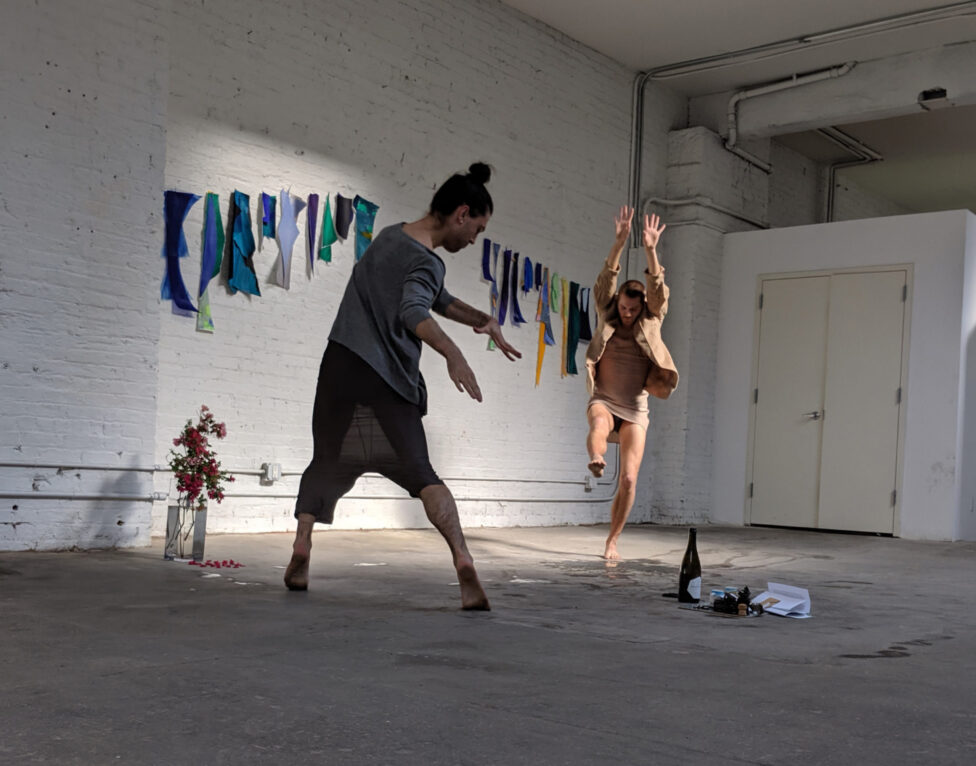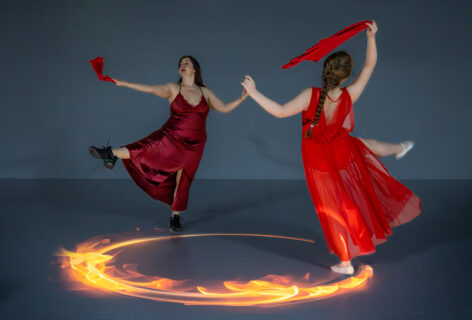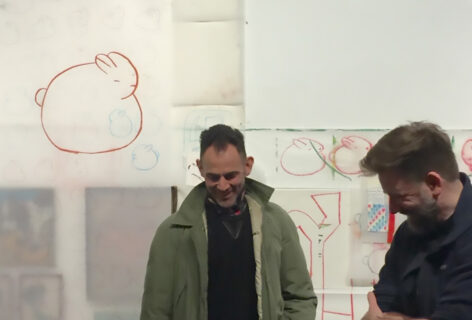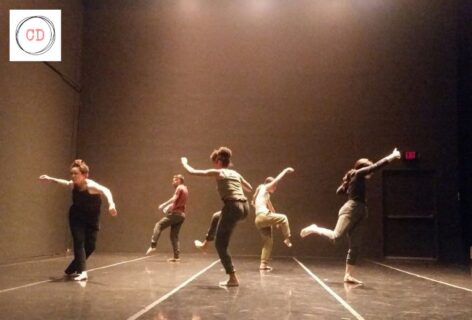Iris McCloughan: I’m already thinking about character. I recently saw your showing of Ruth at Danspace as part of Draftwork, and something that excited me was how it felt like the piece had a sense of character popping in and out. There were these vivid characters that would appear suddenly and disappear suddenly. I’m wondering if you deployed that intentionally or if it’s something that happens through the process.
Doug LeCours: I think it’s kind of a mix, like the character that Anna Witenberg is inhabiting in the piece…
IM: She’s screaming…
DL: She’s screaming really loudly. It’s a very clear nod to the archetypal woman-in-distress of horror films and it is based on the film Possession. So she’s literally reenacting the scene as best she can. That was something I set out to do. I said, ‘I want to recreate this scene and have you embody this character.’
IM: Why?
DL: I’ve been obsessed with this scene. The scene is ten minutes long, and Isabelle Adjani is having this demonic possession. It’s a miscarriage of a demonic child she is carrying… at a subway station.
IM: [Chuckles]
DL: It’s very dancerly, like the body she’s inhabiting is really virtuosic. I thought that Anna would be perfect in that role and when I suggested it to her, she said “All I’ve ever wanted to do is recreate that scene from Possession.” Then we had our own durational performance where we were reenacting different scenes from that film. I played the male lead and she played the female lead and we worked with dialogue. She has a really good French accent that sounds a lot like Isabelle Adjani’s. So that’s an interesting thing to think about just because it came from another world of research that I always knew would be the finale of this showing. Whether it has anything to do with what comes before is a different question. The other character elements in the piece came about more improvisationally, although I was already thinking about Elizabeth Holmes and Theranos, and the way the CEO embodies this kind of strange persona, deepening her voice to be more convincing as CEO. The way characters are deployed in the piece is through a shifting of modes.
IM: My training is in physical theater, and the way that I learned in that tradition, one of the ways I was taught to approach making work is to begin with character. The process of building a character is almost always physical; what is the posture, does the character lead with their pelvis, chest, or nose? Generally the director, or whoever was leading this process of investigation, would help you as the performer/creator to begin to imagine the contours of that specific body and how it moves, and they would lead you through an actual exploration of the movement, like walking around, beginning to move more quickly or slowly and interact with simple objects. Almost always there would be this moment when they would say “Now turn the character all the way up.” They talk about it as dosage. They say, “turn the dosage of this character up to 100%” and you would inhabit that body for a while and gather information about how that body might move, and slowly they would dial you back down to a point where you would be a recognizable person, or closer to a recognizable person. And I think something that is interesting about the way character was functioning in your showing was that I felt that some of the performance was riding that line, and especially in that last section, there is this sense that sometimes Anna is firmly in the extra-human possessed state, and other times she’s just below it, like slyly commenting. I’m wondering how or if you choreographed that performance state, or if it emerges in collaboration with the performer.
DL: That’s interesting. One logistical issue with the score is that it’s incredibly taxing for her to embody this thing for a long time. So it’s kind of still an emerging thing in that she’s calibrating the tone of it for her own safety, as much as for her own interest. I find myself interested in performers who have a kind of embedded critique in the material that starts to seep out. When I am performing, I am also interested in that, so I’m drawn to people that can do that. It’s not often something I’m talking about with them but maybe I’m giving them imagistic or poetic directives to arrive at that, but there’s a risk of saying, “I want you to seem like you know what you’re doing,” as that can lean a little bit too far into parody.
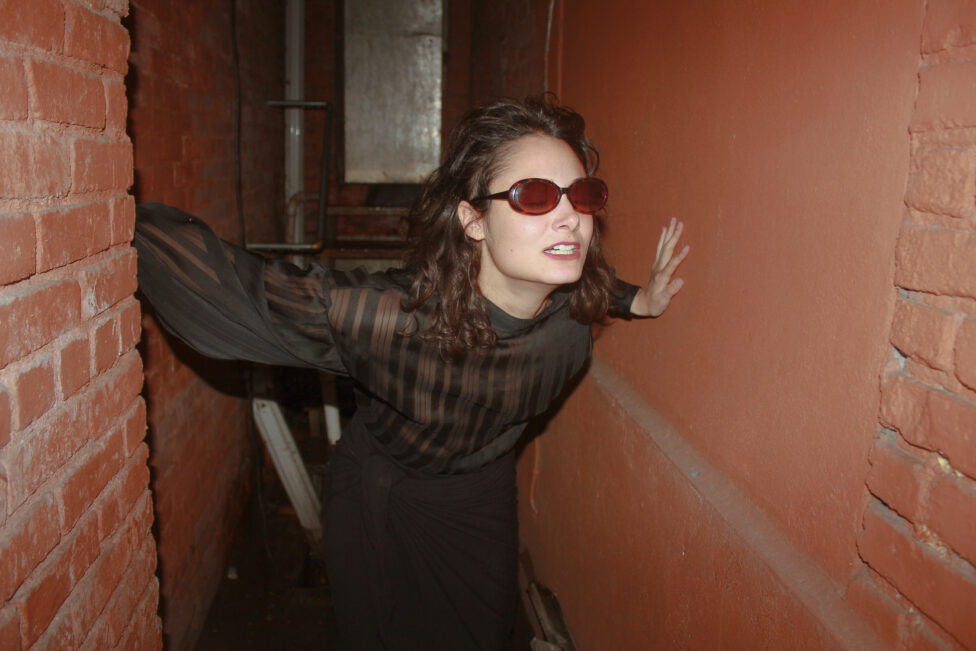
Anna Witenberg, photo by Jessie Young
IM: We’ve talked about this in our process of making work together, the question of how you can be both rigorous or serious about a character or embodiment and also leave room for a little gap to peek out or moments of critical distance to emerge. I often feel like that process is the most important choreography in a piece, how the performers are showing that they know what they’re doing. It’s not always a fully transportive trance state.
DL: I’m interested in creating a porousness in every work in some way whether that’s leaving space for the audience to project their desires or their fantasies, whatever it may be. But also that kind of slippage between, is this the thing, is this the commentary on the thing, or some combination thereof? That feels like where I usually head. I’m sure it’s possible in other forms but it feels uniquely possible in a form that isn’t only about language and that allows a kind of choreography of presence and performativity.
IM: But I think in that showing there was also this really great elliptical sense of meaning. I was really interested in how language entered and exited the piece. I’m wondering if you can talk more about how that functions as you’re preparing to show something.
DL: I’m always toggling between my interest in language and my interest in movement, and I sometimes find myself in a self-imposed pressure like, I need to make a dance, just a dance, that doesn’t engage in other layers of meaning, but language always comes back because it’s something I’m thinking about all the time. With this particular ensemble of performers, I started working with them on these conversation scores two years ago, in which they continuously generate new linguistic content over and over and over. When I started working in September I started to think, these are people who also have this ability to move, to dance, and so then I started to allow more physical expressions to be possible in the room. The biggest language component in this piece is Mariam Dingilian’s monologue at the end. It actually follows that same kind of continuous generating of new content and there’s an allowance for it to be logical or illogical.
IM: Because it’s improvised?
DL: It’s improvised. It’s always had an element of this Theranos lore about a startup and its CEO who duped everyone out of their money, because I’m interested in this kind of narrative of gaslighting and the line between truth and fiction. So in that I’m directing her to keep finding new things, to go faster, to go slower, to change the tone of her voice, to get to a place where she is speaking faster than she can think, and also allowing time to trail off and get bored. For me it functions choreographically in that it’s about tone and timing and how long something lasts, and the feeling of the room has a certain thing of unfolding. Can I ask a selfish question?
IM: Sure.
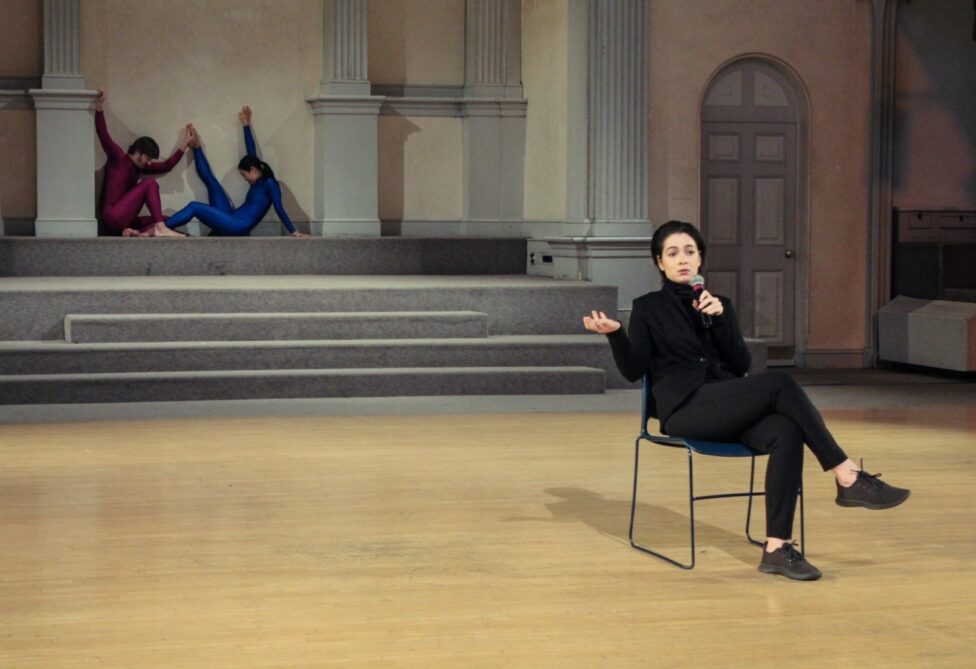
Justin Faircloth, Annie Heath, and Mariam Dingilian in Ruth at Danspace, photo by Jessie Young
DL: We’re talking particularly about this showing and there’s this dance sequence in it that to me feels like a dance sequence. Can I ask what that does in relationship to these other things we’re thinking about?
IM: I mean, it’s very presentational, obviously. In that section the dancers are in a line, they’re facing front, they’re moving upstage and downstage in a pretty synchronized manner. So it felt like a sudden eruption of formality which, thinking about the showing as a whole, to have that as a central anchor, and I don’t know if it actually is central in terms of the arc of the piece, but it kind of felt that way… I’m having trouble talking about it because it taps into something about a poetic sensibility that I really respond to in your work and I think is part of our shared exploration. It’s like I have this feeling there’s meaning in the immediate juxtaposition of that extremely formal section with the improvised text, but I can’t quite articulate why and I also don’t want to.
DL: I feel like that’s what we arrived at in working with Julie Mayo to some degree. A kind of willingness to surrender to an embedded meaning or a subaltern system of logic that’s not based in language or logical thought.
IM: Although, I think for me, language was part of what made that process so rich. I’m also a poet, and it felt like in our research and preparatory work with Julie for that piece (Terrific Freight at The Chocolate Factory in 2018) it did really feel like we were allowed to talk at length. Though there wasn’t much language in the final piece, maybe ten or twelve words if I think through quickly, Jessie Young said, “I got a hand…”
DL: Yeah, she was naming body parts.
IM: …I got a foot” and then I had one line that changed every night. So there were those flashes of that language, and now I’m thinking back to that process and it’s dripping language in a way. We were always trying to articulate what was happening in the room. We were allowed to propose, Julie calls them “Worldings,” which are a practice of shared world-building. I always felt very free to have those be language-based, and I got the sense that you did too. The ones that I remember you proposing often felt like theater exercises. They were concerned with language, with events, with relationships. Where did we start on this topic? I’m lost… My reverie.
DL: Thinking about a logic that maybe the audience doesn’t have access to but is felt to be present.
IM: So, in Julie’s process, which was basically a full year, it felt like all of those words, and that language and that logic, it built up, and that build up got compressed and distributed throughout the piece. As a performer, there was a real sense of logic, but I think for me outside the piece, that logic remains impenetrable, which I think we both talk about as a feeling we’re interested in creating in our own work. If you think about that feeling or effect explicitly, how do you push that task?
DL: I think I’m interested in the slippage between a really legible presence, like, “Oh this person is copying this,” or is embodying this recognizable form as a character, but then it’s fallible, it’s flimsy, like cardboard or something, and you’re not quite sure how fully formed it is. Or it’s slipping in and out of fully formed-ness. Which to me is the pleasure of making a performance that doesn’t adhere to a suspension of disbelief that is associated with classical theater. There is that freedom to play.
IM: Yeah, I think that freedom is why I don’t really call the work I make theater anymore. I think it’s maybe because there’s something about the discipline or field of dance that is more tolerant of ambiguity.
DL: I think we’ve seen in dance a kind of expanded field where there’s a lot more on the table than there used to be.
IM: Do you have training in theater?
DL: I have very little training in theater. In high school, maybe a couple classes, nothing really in college. I’ve been in a play.
IM: It’s funny because I feel like in your showing and in our work together- we’re making this performance which is inspired by Flowers in the Attic, which, for people who don’t know, is a weirdly persistently popular young adult novel about a family of children who get locked in an attic by their mom, who is also trying to poison them, and two of the children end up sleeping together. It’s a deeply plot heavy book, and that’s why we both connected with it, because it’s so dense with plot and so outrageous. I’m losing my train of thought…[laughter] I’m just remembering all the things that happen in Flowers in the Attic.
DL: So many events.
IM: Oh, I was talking about this sense that I have of you, which is that watching your showing and working with you in the studio, you do have a sense of theatricality and rhythm, and what’s exciting to me about some of the work that we have been doing is that you are engaging in that form and totally dropping it or letting it get diffuse and moving through that light fog of theatricality.
DL: Yeah, so I started as an Irish step dancer.
IM: Confession.
DL: Deep confession.
IM: [Laughter]
DL: When I think back on it, the whole system of Irish step dancing exists in this competition setting where you’re doing these two-minute dances. And you’re doing them on stage with two other dancers and it’s like, who’s the best of these dancers? So there’s this sport element but they’re often in these high schools, convention centers, and hotels, so when I think back on it, those were performances, strange microcosms of society in these weird rooms where you’re watching kids in glittery costumes do these strange footwork dances. But that has such a relationship to spectacle, and then I was a competition dancer doing jazz, tap, hip hop, all of those kinds of things, which also have to do with spectacle. Then I found myself in a more postmodern lineage of training when I got to college and it was all about neutrality and all about a kind of letting go of self and character to embody physical reality and momentum and weight and form.
IM: That’s bringing up this memory of physical theater training environments, and this concept of the neutral body being such an anchor. I remember having the sensation of not really knowing what neutral means. Other people seemed to be able to tell when they had been in a neutral body, and I think I had a lot of skepticism of that possibility. It’s interesting, I’ve never drawn that connection between the world you’re describing and that experience.
DL: So much of the postmodern movement had to do with I am myself on stage, I am Doug LeCours on stage, I had a sandwich for lunch, and I’m moving my elbow in this way. There’s a kind of realism to that, and then around the end of college I started to find my way into language and plot and story and to re-engage with those things, because I’ve always been drawn to them. I think film is almost a link, because when I watch films I feel like I’m watching dance in terms of how shots are choreographed and edited and spliced together. That became a bridge for me between this postmodern thing and my past with spectacle. That’s how I arrived at allowing that to be in the room, and getting more familiar with working with voice has been a way to allow for that.
I’m wondering how you came to dance, and how you feel like that relates to how character is deployed in the work you’ve made before.
IM: Well, I studied theater, that was my major in undergrad, and while I was in undergrad I met Eiko [Otake] and worked as an assistant for Eiko & Koma. In 2014 I stepped into a new role as Eiko was finishing a solo project, and I became her dramaturg/outside eye. I would help her approach a site, figure out potential pathways through that site, potential actions, and help her fine tune what she did to make sure it would have the effect she wanted. I think part of why that worked, part of why I think I’m good at that job, is because I have this background in physical theater. If I think about what sort of knowledge I’ve cultivated while doing that work, it has been like growing this sensitivity to when the character or narrative should cohere and when it’s useful to let that go and move into something that’s more about a purer sense of presence, the relationship between the performer and audience, performance and space, all that stuff. While I was doing that I was making plays, and then just started experimenting with performances that didn’t have words. My collaborator Jaime Maseda and I made a half-hour dance, and that felt really great. It felt like a relief to not have to solve the piece in terms of sense. And also, I have to say, it felt really good to give ourselves permission to not care if the audience understood it on the level of coherence that I think people expect when they’re watching a piece of theater. We could suddenly feel successful about having created a piece that made sense on the level of affect, a kind of intuitive level. As we kept making work, it felt like we were circling around dance. Then we made a dance called THE TOP, which was really about pure presence. It was a lot of repetition, and we were thinking about that repetition as a way to show ourselves. Since then, I’ve been approaching making work from a dance framework because it allows access to that space of not having to tie things up neatly, which again, as a poet, I feel like that’s when I’m most successful. When something feels incomplete in the right way, which is maybe my ultimate goal in making anything.
DL: Incomplete in the right way!
IM: Incomplete in the right way!
DL: That makes a lot of sense to me. When you’re talking about poetry, I’ve never really identified as a poet …
IM: But you are a writer.
DL: I am a writer. I identified as a poet in high school. I was like I’m a poet, I write poetry. And then in college I’d write short fiction. That was the form I was most drawn to, I was really drawn to Carver and minimalism. I went to this writer’s conference, and this other young millennial writer guy and I became known as the young…
IM: The young minimalists? [laughter]
DL: And honestly the dances I was making at that time were pretty sparse explorations of form. Then my senior year I started to write these long form monologues that arrived through these webcam video performances I would make and then transcribe the text. So they’re long form, but there’s a poetic logic to them in that there’s not an A to Z kind of story that’s being told in a legible way. I feel like you’re helping me isolate something I’m interested in, and I think it’s happening in our work. It’s an interest in using legible, clear, narrative forms, the beginning, the middle, and the end, and restructuring them or letting them speak at certain moments and quieting them at others. Chris Kraus in Aliens & Anorexia talks about deploying the “idea of movie” in making a film because she doesn’t really know what she’s doing when she’s trying to make this film. I feel like this comes up in my consciousness a lot, and in this case maybe it’s the “idea of story,” the idea of plot slithering in and then leaving the room
I’m curious about Teena. If you could talk a little about who Teena is, and whether you started with an interest in the character of Teena or if it sort of emerged.
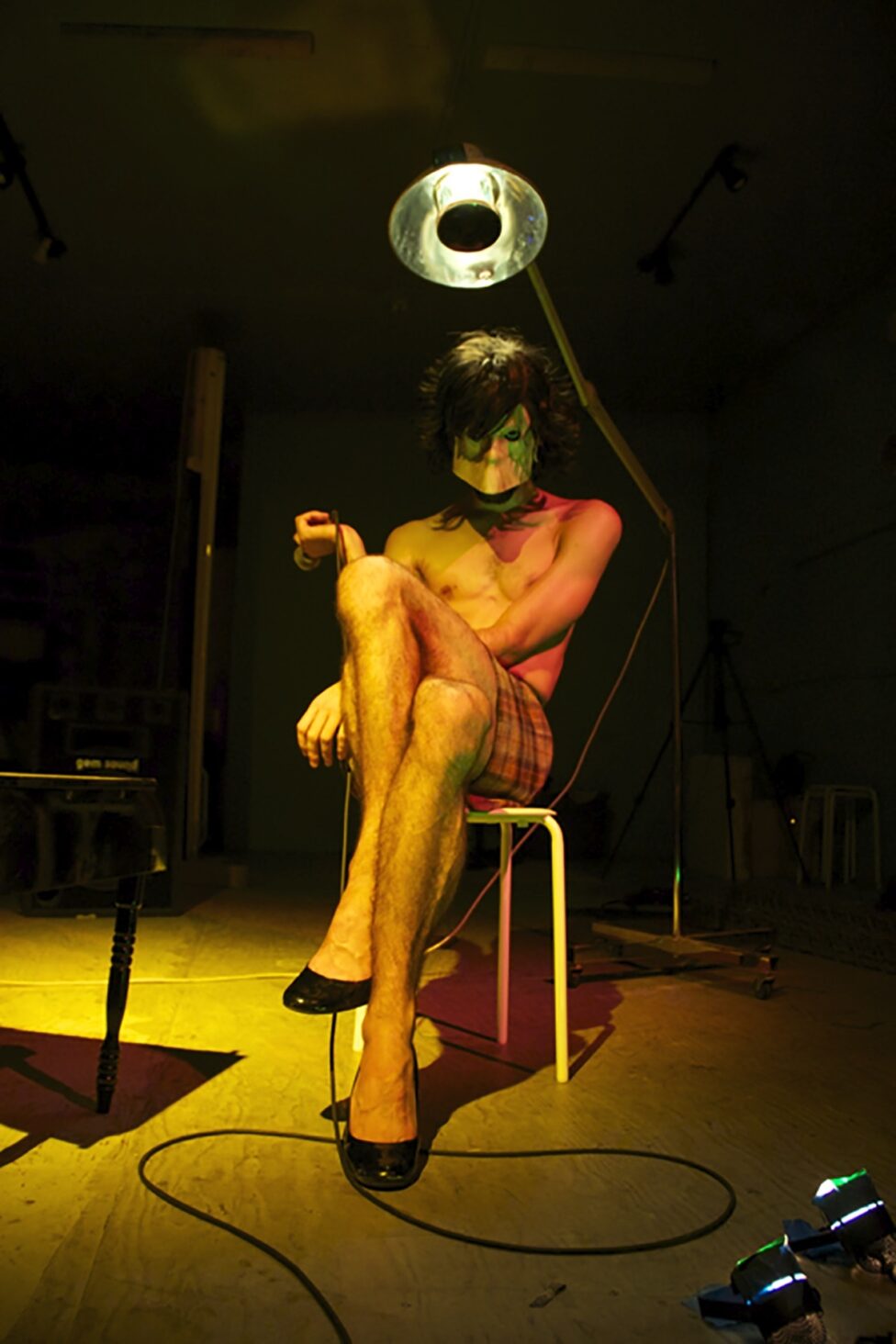
Teena Geist, in The Beautiful Refrigerator is Empty, photo by Spencer Sheridan
IM: Teena Geist is a character that I perform who is this demonic teenager. I feel like we should mention that we’re both interested in teenagers and demons.
DL: [laughter] 100%.
IM: The process of creating that character, which is sort of a cabaret character in that it’s improvised 100%, it feels like creating that character was the thing that gave me the experience I needed to begin making dance. In that framework of playing this character, and having to create story and relationship with the audience out of nothing, I felt like I got so comfortable just beginning with my body. Weirdly, having theater training, there’s this sense that as an actor I needed something else to begin. Like I needed a script or I needed someone to tell me what to do. Which was an idea that I started to break for myself when I began making original work with collaborators. And then suddenly having this character, Teena, which almost felt like possession, to bring things full circle, I began to see how I could trust that my body and my presence and my brain in the moment were sufficient tools to make a performance. I think that sense of letting something cohere on its own, a narrative spine… I love that phrase you used, “slithers in.” I feel like I learned it by doing that character, and then learned how to apply that sense to making other performances with other people that might live in other kinds of settings.
DL: It sounds like an improvisational framework, working with the here and now, this moment I’m having with this audience. Does the character of Teena shift as a performance goes on?
IM: Well, another thing we’ve been talking about in this conversation is that critical distance.
DL: Totally.
IM: In that character, I learned how to do that. It’s how I learned to choreograph these moments of being really committed to the coherence and integrity of the character, and then rapidly shifting to having a stance as a performer that that character is not me, and that I know that, that I’m making that character do that thing intentionally to say this.
DL: That just sends me flying in so many directions, because I envy people who can make things where everyone seems to be under the spell of the director, just because I’m interested in this more nebulous slippery space where the performers have a little bit more freedom than that. And we recently were talking about if we should have more people in this collaboration, and thinking about Richard Foreman and directors who are kind of like omnipresent god-like figures, and that’s such an interesting thing to think about those different roles..
I’m thinking about teenagers and demons, and I’m looking at this picture on the wall of my senior thesis which was called My Sad Girl Dead Boy Prom Night Pity Party.
IM: Oh my god.
DL: And thinking about the piece we’re starting to make, I didn’t quite realize how much of a logical progression it is, at least for me, in terms of things I’ve made in the past.
IM: It feels like a logical progression for me too. I think the figure of the teenager is such a rich one, for the way in which it can ping pong wildly between a fierce coherence and an emotional dissolution.
DL: That’s a lovely turn of phrase. And a shifting nascent identity. That is very exciting to choreograph.
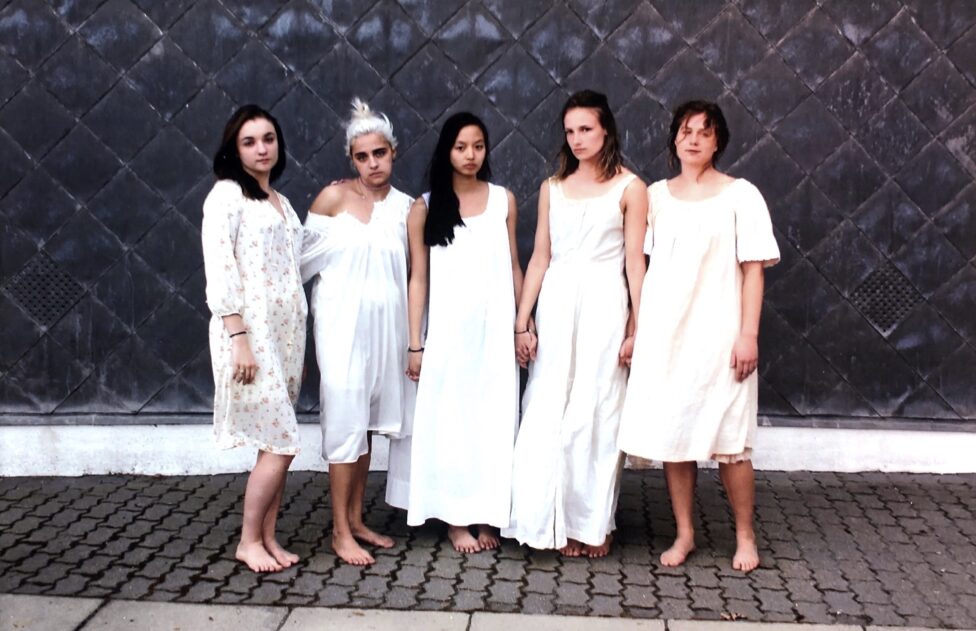
My Sad Girl Dead Boy Prom Night Pity Party, performers (L-R) Annie Powers, Jules Alice, Emily Luan, Sarae Snyder, & Meredith White.

